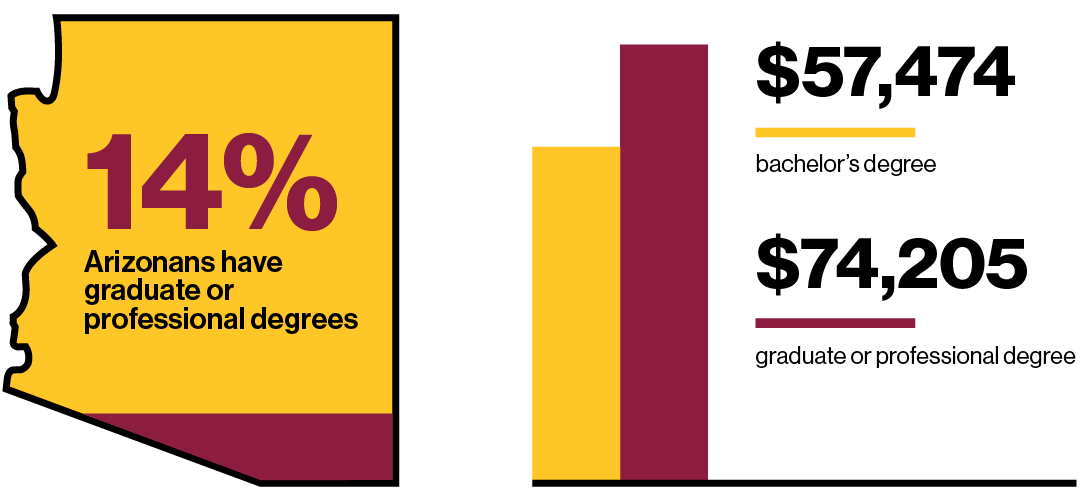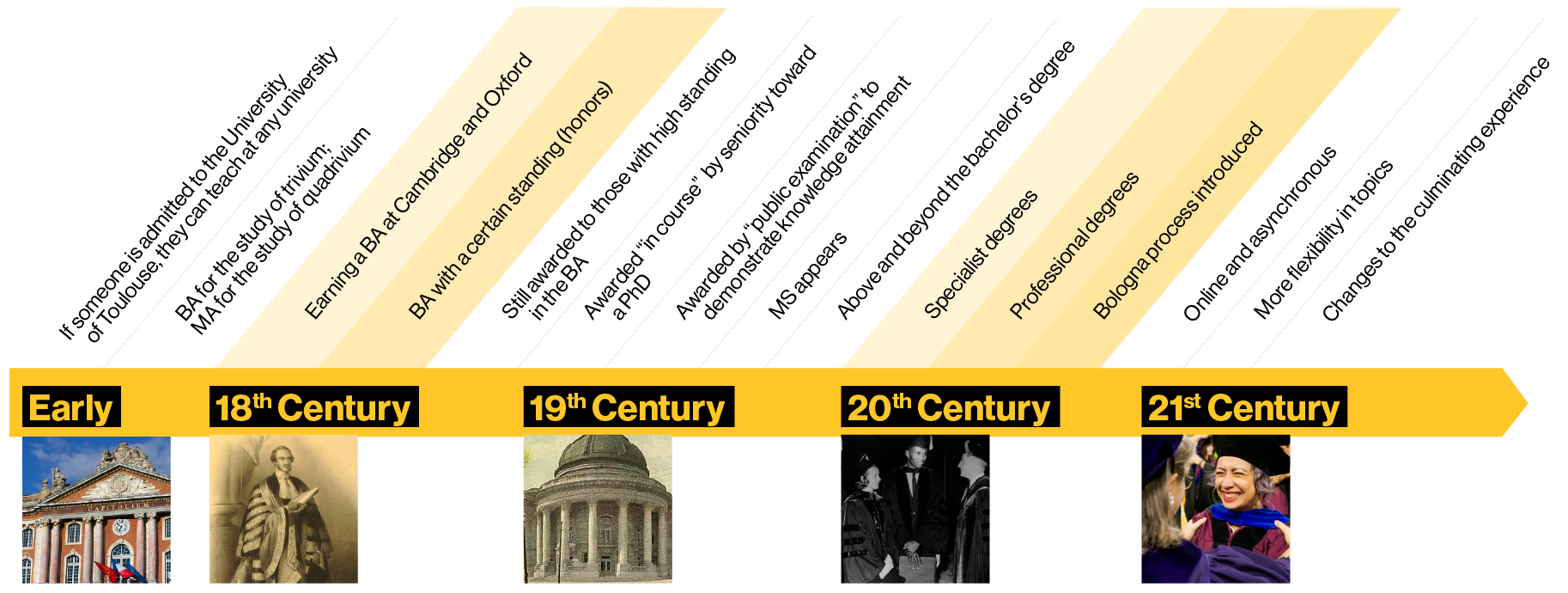
A history on master’s degrees and what it means for you
ASU's Graduate College has awarded over 160,910 master's degrees during the last 85 years — this is a fantastic number of Sun Devils. Today, more than 22,000 ASU graduate students are pursuing master's degrees. But why are people interested in master's degrees?
The value of earning a master’s degree
Conversations suggest that most graduate students pursue master’s degrees because they need them for their careers. This is a good reason because workers with graduate degrees can earn up to 20% more income, depending on the field. The number of individuals (age 25 and over) with graduate or professional degrees (including master’s, JD, PhD and other degrees) in Arizona is about 14% of the state’s population, somewhat higher than the national average (13%). In Arizona, the median salary with a bachelor’s degree (in 2020) was $57,474; with a graduate or professional degree, the median salary was $74,205 (U.S. Census) (Figure 1). This is strong evidence that the skills and knowledge gained during a master’s degree are recognized and rewarded in the job market.

What is a master's degree?
To begin this conversation, let’s start with a definition and some history. The master’s degree, like much of higher education, has roots in Europe and early North America and has evolved over the centuries(Figure 2). The master’s degree dates back to the Middle Ages in Europe, when the first-known master’s degrees were awarded to individuals who studied both the trivium (grammar, rhetoric and logic) followed by the quadrivium (arithmetic, geometry, astronomy and music), together making up the seven liberal arts. Earning a master’s degree (quadrivium) allowed scholars to provide instruction at other European universities. By the 18th century, the master’s degree was simultaneously awarded with a bachelor’s degree from Oxford or Cambridge. The bachelor’s degrees from Oxford or Cambridge were considered superior in quality and thus were believed to be deserving of a higher distinction. Other institutions in England awarded master’s degrees to students earning high marks or honors during their bachelor’s degree program
The evolution of the master's degree
By the 19th and 20th centuries, a rapid evolution occurred with the appearance of master of science and specialized master’s degrees (e.g., the master of business administration, master of architecture, master of fine arts). The commonality that ties these degrees is that they indicate more profound knowledge in a specialized field than those with a bachelor’s degree. This idea remains true to this day. How people demonstrate the additional knowledge they’ve acquired differs, and varies by degree program, but is usually a combination of coursework, testing, research and projects.

Why is a master’s degree essential in the 21st century?
During the 21st century, master's degrees are in transition again — often focusing on specific skills for jobs and careers. Learning job skills is essential. More articles are written on why employers are starting to dismiss a college degree as a hiring requirement. Michelmore (2023) described how people are beginning to acquire unique credentials for jobs, which could come from college or other educational platforms. The concern is that people could become too specialized, and the skill sets needed will change over time. Individuals with overly technical skills may not have the ability to pivot quickly.
Today’s careers require pivot skills
The idea that students need to be trained to pivot within their career path was part of my philosophy in my teaching. My field is geographic information science, which includes geographic information system mapping (GIS), remote sensing, and spatial statistics, with teaching that includes data skills, programming, modeling and so-called “hard” (or technical) skills. During my teaching career, I have emphasized the importance of “concepts” behind the technology — asking students why we are using tools and not just teaching them the “point and click” steps to use the software. In my early teaching years, students were frustrated that I wasn’t teaching them enough about how to use the software. A few years later, some of those same students wrote to express how happy they were that they learned the core concepts, that five years after my class, they still employed my lessons even though the software had changed.
What did I learn from this as a teacher? Well, it reinforced the importance of strengthening non-cognitive skills. Typically (especially for undergraduate curriculum), universities include critical thinking, problem-solving and communication as the primary non-cognitive learning outcomes. These are also important during graduate work, and I add to these: initiative, industriousness and curiosity.
Initiative
You take charge of your course of study. This is important because, unlike an undergraduate degree, which mainly involves taking classes, graduate work includes creating something new.
Industriousness
You are persistent in reaching a goal. This is important because creating something new is challenging and requires persistence.
Curiosity
You are inquisitive and eager to acquire fresh knowledge. Curiosity is a trait that encourages an adaptive mindset that is needed in a rapidly changing world.
I hope you take the initiative, feel industrious and strive to be curious.
— By Dean and Vice Provost Elizabeth Wentz
P.S.
If you're curious, I'll tell you about a little secret. If you've been reading the Dean's Desk, you've already learned that some of my hobbies are music and triathlons, which help me with my well-being. Another one of my hobbies is jigsaw puzzles – below is the latest puzzle that I finished!
More stories from the Graduate Insider

Graduate funding deadlines for Fall

Humanities Week: The Critical Language Scholarship
